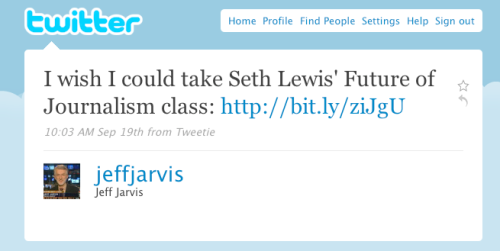As I mentioned in class yesterday, during the next week I’d like you to explore Twitter—and if you already have an account that you use regularly, great! Just make this an “advanced Twitter” session for yourself.
Here’s the rundown:
—get familiar with using Twitter by checking out Sree’s Guide to Twitter for Newbies & Skeptics (obviously, you don’t need to follow all of those links, but look closely at parts that seem of most interest/value to you) and Mashable’s guide to Twitter (again, just skim this stuff);
—then, and more importantly, read this short piece with tips for using Twitter as a journalistic tool;
—now, go forward posting 3 times/day during the next week—focusing more on “mindcasting” ideas and sharing interesting links than simply “lifecasting” your day;
—start following at least 25 people and 5 lists;
—and in your tweeting use the class hastag #j349, so we can track each other’s tweets;
—lastly: search using the hashtag to be able to find and follow each other during this week.



Recent Comments